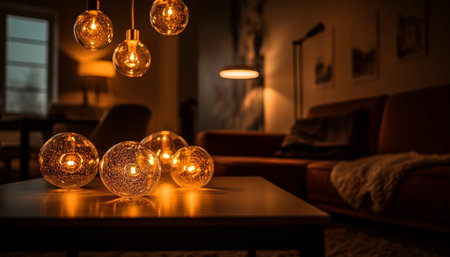Introduction to DIY Lighting in British Homes
When it comes to giving your home a unique, personal touch, lighting plays a pivotal role—especially in Britain, where the weather and architectural styles make clever illumination essential. DIY lighting offers British homeowners the perfect blend of creativity and practicality, allowing you to customise your living space while keeping costs down. Whether you live in a Victorian terrace or a modern flat, adding your own flair to lighting can transform any room. This approach not only embraces quintessential British charm but also addresses the practical needs of our often-overcast climate, making your home more inviting and energy-efficient. In this series, we’ll explore how simple, affordable DIY lighting projects can enhance both the character and comfort of your home, tailored specifically for British tastes and living environments.
2. Repurposing Vintage Finds for Unique Fixtures
If you’re seeking a truly British way to illuminate your home with personality and charm, look no further than the treasures waiting in local charity shops and car boot sales. Repurposing vintage finds into bespoke lighting fixtures is not just an affordable solution, but also a wonderful nod to Britain’s appreciation for history and craftsmanship. Imagine turning an old teapot from a village fete or a battered enamel colander found at a Sunday market into a one-of-a-kind lampshade—your living room will instantly gain a talking point with real heritage.
Why Choose Vintage?
Repurposing vintage items isn’t just about saving money; it’s about sustainability, creativity, and celebrating the stories behind everyday objects. Each piece you rescue from being discarded carries its own bit of nostalgia, adding warmth and character to your space. This DIY approach also allows you to tailor your lighting exactly to your taste—whether you prefer the industrial look of old factory equipment or the classic elegance of cut crystal decanters.
Popular Vintage Items for Lighting Projects
| Item | Potential Use | Where to Find |
|---|---|---|
| Teapots & Jugs | Pendant light shades or table lamp bases | Charity shops, car boot sales |
| Bottle crates & wooden boxes | Wall-mounted sconces or cluster fixtures | Flea markets, vintage fairs |
| Mason jars & decanters | Clustered pendant lights or fairy light holders | High street charity shops, attic clear-outs |
| Colanders & metal kitchenware | Pendant shades with playful patterns of light | Car boot sales, local jumble sales |
| Candle holders & lanterns | Wall lights or garden festoon lighting | Antique markets, online marketplaces (Gumtree, eBay UK) |
Tips for Safe and Stylish Conversion
When repurposing any vintage item into a lighting fixture, always ensure electrical safety first—use certified lamp kits from UK suppliers and consult an electrician if in doubt. Clean all materials thoroughly and check for structural integrity before assembly. Add finishing touches that suit your décor: consider using fabric-covered cables for a traditional look or Edison-style bulbs for that soft nostalgic glow.
This blend of resourcefulness and style not only saves money but also helps to preserve a slice of British culture within your home. By reimagining forgotten treasures as unique lighting features, you’ll create spaces that feel both personal and steeped in authentic British flair.

3. Sustainable and Upcycled Lighting Solutions
If you’re looking to add a touch of British charm to your home without breaking the bank, sustainable and upcycled lighting is the way forward. By embracing eco-friendly materials and upcycling methods, you can create bespoke light fixtures that are as stylish as they are environmentally conscious.
Eco-Friendly Materials for DIY Lights
Start by sourcing materials that have a minimal environmental impact. Think recycled glass jars, old teapots, or even unused wine bottles—items commonly found in many British homes. These can be transformed into unique pendant lamps or quirky wall sconces with just a bit of creativity and some basic tools. Using energy-efficient LED bulbs not only reduces your carbon footprint but also keeps your electricity bills in check.
Upcycling Everyday Items
The art of upcycling is all about giving new life to things that might otherwise end up in the tip. Why not turn vintage colanders or copper kettles into rustic ceiling lights for your kitchen? Or string together leftover jam jars with fairy lights for a whimsical garden feature. The key is to let your imagination roam free while keeping an eye out for items with potential around your home or local charity shops.
Affordable, Sustainable, and Uniquely British
One of the best aspects of sustainable DIY lighting is its affordability. Upcycling not only saves you money but also allows you to infuse your home with a sense of personal history and local flavour—qualities at the heart of British interior style. Whether it’s a nod to industrial chic using reclaimed wood or a cottagecore look with floral-patterned tins, sustainable lighting solutions ensure your home remains both inviting and distinctly yours.
Cosy Cottage Vibes with Soft Illumination
Embracing the essence of British cosiness is all about creating a warm and inviting atmosphere reminiscent of a charming countryside cottage. The right lighting plays a pivotal role in achieving this, especially when you opt for soft, ambient illumination that transforms your living spaces into snug retreats. In the UK, layering gentle light sources—such as fairy lights, lanterns, and candles—remains a beloved approach to home comfort.
Layering Your Lighting for Ultimate Cosiness
Start by draping fairy lights along mantlepieces, around window frames, or even within glass jars. Their delicate glow gently brightens nooks without overwhelming the room. Lanterns, whether vintage metal or rustic wood, can be placed on side tables or hung from hooks to add character and charm. Candles—real or LED—introduce flickering warmth ideal for unwinding after a blustery day.
Comparing Soft Lighting Options
| Lighting Type | Ambience Level | Placement Ideas | Cost Effectiveness |
|---|---|---|---|
| Fairy Lights | Mildly warm, whimsical | Mantlepieces, shelves, jars | Very affordable |
| Lanterns | Moderate warmth, rustic charm | Corners, tables, garden paths | Affordable to moderate |
| Candles (or LED alternatives) | Warmest, soothing glow | Coffee tables, bathrooms, dining areas | Highly affordable |
Maintenance Tips for Lasting Cosiness
To keep your soft lighting at its best, dust fairy lights regularly and check for any faulty bulbs. For lanterns and candleholders, wipe down surfaces to prevent soot build-up and ensure safety if using real flames. Opt for LED candles as a practical solution in busy family homes—offering all the ambience with none of the fire risk. With these simple DIY touches, you’ll capture that signature British cottage feel while keeping your energy bills low.
5. Statement Pieces: Creating a Focal Point
If you’re looking to infuse your home with unmistakable British character, statement lighting is an excellent way to do so. A standout lamp or pendant light can quickly become the centrepiece of any room, drawing the eye and sparking conversation. The great news? You don’t need to splash out on designer pieces—DIY options allow you to create bespoke focal points that truly reflect your style.
Hand-Painted Lampshades
Transform a plain lampshade into a work of art with just a bit of paint and creativity. Use classic British motifs—think florals, tartan, or even Union Jack-inspired patterns—to give your shade some local flair. Acrylic paints are ideal for fabric shades and offer a quick-drying, durable finish. Don’t be afraid to experiment with colour palettes that complement your existing décor, from heritage hues like deep green and navy, to pastel tones reminiscent of seaside cottages.
DIY Tip:
For crisp lines, use painter’s tape or stencils. If you make a mistake, simply let the paint dry and layer over it—DIY projects are all about learning as you go!
Industrial Pendant Lights
Industrial lighting remains a favourite in many British homes, blending vintage charm with modern sensibility. To make your own, source old wire baskets, colanders, or even copper piping from local markets or car boot sales. These materials can easily be repurposed into striking pendant lights with the addition of a simple bulb fitting and some sturdy cord.
DIY Tip:
Always check the weight of your chosen materials before hanging them, and ensure all electrical fittings meet UK safety standards. Consider using LED bulbs for energy efficiency and longevity.
Adding a Personal Touch
The beauty of DIY statement lighting is the freedom to personalise every detail—from the colours and finishes to the type of bulbs used. Why not add decorative trims, such as ribbon or fringe, to your lampshades? Or spray-paint metal fixtures in bold hues to match your room’s theme?
Final Thought:
Statement lighting isn’t just about illumination; it’s about expressing personality and creating a welcoming atmosphere unique to your home. With these DIY tips, you’ll add both character and value while embracing affordable British flair.
6. Safety Tips and Electrical Know-How
Understanding British Wiring Standards
When embarking on any DIY lighting project in the UK, it’s crucial to understand the essentials of British wiring standards. The UK uses a 230V supply voltage with a frequency of 50Hz, and all fixed wiring should comply with BS 7671, also known as the IET Wiring Regulations. Always check that cables, fittings, and switches bear the British Standard Kitemark for safety and reliability. Remember that the wiring colours in the UK are brown (live), blue (neutral), and green/yellow (earth).
Essential Do’s and Don’ts for DIY Lighting
Do’s:
- Switch off power at the mains before starting any electrical work.
- Use a voltage tester to ensure circuits are dead before touching wires.
- Follow installation instructions provided by manufacturers.
- Use appropriate tools and PPE such as insulated screwdrivers and gloves.
- Label your consumer unit (fuse box) clearly after making changes.
Don’ts:
- Never work on live circuits or attempt repairs if you’re unsure about wiring layouts.
- Avoid overloading sockets and extension leads—this is a common cause of household fires.
- Don’t mix old and new wiring without proper connectors or junction boxes.
- Never bury connections in walls or ceilings without accessible inspection covers.
When to Call a Qualified Electrician
Certain jobs—such as installing new circuits, working in bathrooms, or altering fuse boxes—are notifiable under Part P of UK Building Regulations and must be carried out by a qualified electrician registered with a Competent Person Scheme. If you encounter aluminium wiring, persistent tripping fuses, or signs of overheating, do not proceed: these are signs for professional intervention. When in doubt, always seek advice from a certified local electrician to guarantee your home remains both stylish and safe.


